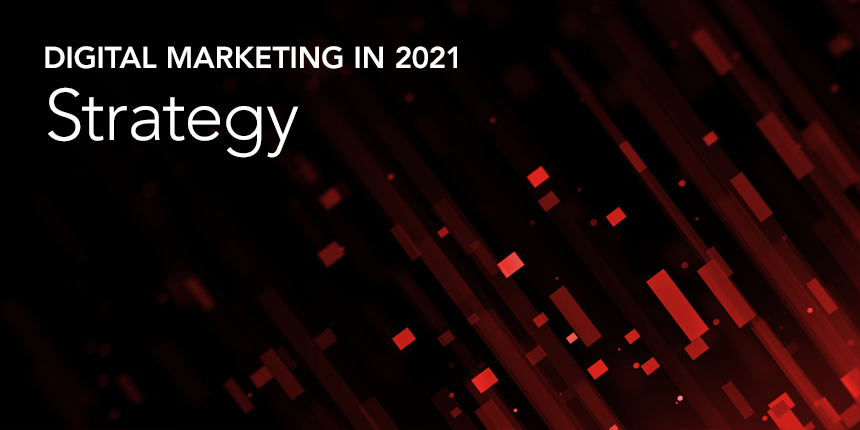Part three of our predictions series brings us to digital strategy–where decisions are driven by data, research reveals surprising truths, and there’s no such thing as too much coffee. Join us as we pick out some of 2021’s most exciting strategic developments.
-
COVID-19 will continue to drive digital acceleration
Okay, so this is a relatively safe one: ecommerce will continue its rapid growth in 2021 as the pandemic continues to impact shopper behaviour. Ecommerce was already growing steadily before 2020, but the “new normal” poured fuel on that particular fire as consumers regularly found themselves unable (or simply unwilling) to shop in store.
According to Adobe, online spending in May 2020 was up 77% compared to the same time in 2019. Meanwhile, Amazon achieved its most significant ecommerce growth in more than three years, while other online retailers such as Walmart, Alibaba, and Target have also shored up their seats at the giants’ table with hugely increased sales.

On a similar note, we’re fully expecting smarter AI implementations to supercharge personalisation in 2021. Recent advances in AI mean marketers are better able to analyse user behaviour, with a host of priceless marketing insights—from buying frequency to brand preferences—now being revealed by the data acquired through AI.
Think of AI’s purpose as being to help sellers understand the needs and preferences of the consumer. By intelligently segmenting the audience, AI not only helps brands understand what their customers want, but also allows them to predict the purchasing behaviour of their target customer in the easiest way possible.
-
Visual and voice search become part of the furniture
Visual search has made huge strides towards mainstream adoption over the past couple of years. In fact, it’s estimated that 62% of millennials now prefer visual search than using Google conventionally. Even Pinterest has adopted the idea of visual search; more than 600 million visual searches are carried out every month there.
In 2021, expect early adopter brands to redesign their websites to support visual search, driving a massive 30% increase in digital commerce revenue before the year is out.
On the voice search front, there will be more than 122 million voice assistant users in the US alone next year. As such, voice is set to transform SEO, specifically local SEO, as users increasingly search for nearby businesses without ever looking at a screen. If you’re not accounting for local search terms (including city, region, and nearby landmarks), you might just be left behind in the next 12 months.
-
Snackable videos and video ads are now on the menu
Short-form video content is becoming, and will continue to be, very popular. With the runaway success of TikTok (and now Instagram’s latest Reels feature), these kinds of snackable, short-form videos will become more popular than ever before in 2021 according to some forecasts.

Their unstoppable rise goes hand in hand with a corresponding increase in social video ad spending. According to eMarketer, social video ad spending in the US will reach $14.89 billion in 2021, growing 44% from 2019, continuing with an estimated increase of 62.1% between 2019 and 2023.
Want to get in on the action? Then your content strategy should start to incorporate short, snappy video assets. After all, Cisco believes that more than 80% of all online content will be video by 2022. The new normal is video.
-
Say farewell to the linear customer journey
It has been thoroughly explored in theory, but now the non-linear purchase journey is finally an everyday reality for modern marketers. With various ins (and outs), this complicated, interconnected process will become established in 2021 as customers come to rely more on ecommerce and other digital channels to discover products, research services, and connect with businesses.
At the same time, mainstream approaches to customer intelligence (CI) will continue to evolve in 2021. Forrester predicts that CI leaders will shift 10% of their insights budget to emotion analytics as they shift their raison d’être from “helpful guide” to “crisis strategist”.
Just remember not to pursue personalisation at all costs. In the words of Proove Intelligence, our data analytics center of excellence:
This common form of digital “personalisation at scale” is in many ways an oxymoron, or a misnomer at best. At its core, it remains a form of mass production—an efficient way to manufacture standardised goods. Our digital factories process raw materials of content and data assets using machinery built out of algorithms to rapidly manufacture online experiences. Though can we infinitely recombine these assets into “unique” but similar experiences, we ultimately strive for certainty towards a finite set of desired standardised outcomes.
-
Get ready for the great SEO renaissance
We’ll cover SEO in greater detail later in the series, but we couldn’t wrap up our strategy predictions without acknowledging the forthcoming SEO renaissance. In short, SEO will experience a resurgence with audience insights strengthening the discipline’s ties to user intent.
User intent, in fact, has become something of a forgotten relic in recent years. Why? Because too many SEO strategies pay scant attention to proper audience analysis, focusing instead on keywords and query matching to the detriment of various other factors.
But SEO now demands a big-picture approach—especially with the dawn of AI innovations like BERT—incorporating long-tail keywords, semantically related search terms, and a deeper, more nuanced understanding of what people are searching for and which kind of content will resonate. Brands that get this right will thrive in SEO in 2021.
Hungry for more? Check out our full predictions series. Eleven experts, seven disciplines, one handy PDF.




